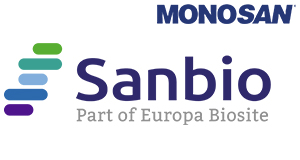Mouse anti-Hu CD5 Purified, clone MEM-32 (Monoclonal)
Mouse anti-Hu CD5 Purified, clone MEM-32 (Monoclonal)
SKU
SANMON23204
Packaging Unit
0,1 mg
Manufacturer
Sanbio / Monosan
Availability:
loading...
Price is loading...
Clone Number: MEM-32
Immunogen: Crude thymus membrane fraction.
Concentration: 1 mg/ml
Format: Purified by protein-A affinity chromatography.
Storage buffer: Phosphate buffered saline (PBS), pH 7.4, 15 mM sodium azide
Additional info: CD5 antigen (T1; 67 kDa) is a human cell surface T-lymphocyte single-chain transmembrane glycoprotein. CD5 is expressed on all mature T-lymphocytes, most of thymocytes, subset of B-lymphocytes and on many T-cell leukemias and lymphomas. It is a type I membrane glycoprotein whose extracellular region contains three scavenger receptor cysteine-rich (SRCR) domains. The CD5 is a signal transducing molecule whose cytoplasmic tail is devoid of any intrinsic catalytic activity. CD5 modulates signaling through the antigen-specific receptor complex (TCR and BCR). CD5 crosslinking induces extracellular Ca++ mobilization, tyrosine phosphorylation of intracellular proteins and DAG production. Preliminary evidence shows protein associations with ZAP-70, p56lck, p59fyn, PC-PLC, etc. CD5 may serve as a dual receptor, giving either stimulatory or inhibitory signals depending both on the cell type and development stage. In thymocytes and B1a cells it seems to provide inhibitory signals, in peripheral mature T lymhocytes it acts as a costimulatory signal receptor. CD5 is the phenotypic marker of a B cell subpopulation involved in the production of autoreactive antibodies. Disease relevance: CD5 is a phenotypic marker for some B cell lymphoproliferative disorders (B-CLL, Hairy cell leukemia, etc.). The CD5+ popuation is expanded in some autoimmune disorders (rheumatoid arthritis, etc.). Herpes virus infections induce loss of CD5 expression in the expanded CD8+ human T cells.SpecificityThe mouse monoclonal antibody 23C6 recognizes an extracellular epitope on CD51/CD61 complex, that is expressed mainly on human osteoclasts, but also e.g. on placenta, or melanoma cell lines. The epitope is native and sensitive to fixation. In chicken this antibody can be used to selectively identify the thrombocytes.Application detailsELISA: The antibody MEM-32 can be used in the Sandwich ELISA as the capture antibody in pair with the detection antibody CRIS1.
Immunohistochemistry (paraffin sections): Recommended dilution: 20 μg/ml; positive tissue: spleen.
Flow cytometry: Recommended dilution: 2 μg/ml.
Western blotting: Laurylmaltoside lysing buffer; non-reducing conditions; recommended dilution: 1-2 μg/ml.
Immunogen: Crude thymus membrane fraction.
Concentration: 1 mg/ml
Format: Purified by protein-A affinity chromatography.
Storage buffer: Phosphate buffered saline (PBS), pH 7.4, 15 mM sodium azide
Additional info: CD5 antigen (T1; 67 kDa) is a human cell surface T-lymphocyte single-chain transmembrane glycoprotein. CD5 is expressed on all mature T-lymphocytes, most of thymocytes, subset of B-lymphocytes and on many T-cell leukemias and lymphomas. It is a type I membrane glycoprotein whose extracellular region contains three scavenger receptor cysteine-rich (SRCR) domains. The CD5 is a signal transducing molecule whose cytoplasmic tail is devoid of any intrinsic catalytic activity. CD5 modulates signaling through the antigen-specific receptor complex (TCR and BCR). CD5 crosslinking induces extracellular Ca++ mobilization, tyrosine phosphorylation of intracellular proteins and DAG production. Preliminary evidence shows protein associations with ZAP-70, p56lck, p59fyn, PC-PLC, etc. CD5 may serve as a dual receptor, giving either stimulatory or inhibitory signals depending both on the cell type and development stage. In thymocytes and B1a cells it seems to provide inhibitory signals, in peripheral mature T lymhocytes it acts as a costimulatory signal receptor. CD5 is the phenotypic marker of a B cell subpopulation involved in the production of autoreactive antibodies. Disease relevance: CD5 is a phenotypic marker for some B cell lymphoproliferative disorders (B-CLL, Hairy cell leukemia, etc.). The CD5+ popuation is expanded in some autoimmune disorders (rheumatoid arthritis, etc.). Herpes virus infections induce loss of CD5 expression in the expanded CD8+ human T cells.SpecificityThe mouse monoclonal antibody 23C6 recognizes an extracellular epitope on CD51/CD61 complex, that is expressed mainly on human osteoclasts, but also e.g. on placenta, or melanoma cell lines. The epitope is native and sensitive to fixation. In chicken this antibody can be used to selectively identify the thrombocytes.Application detailsELISA: The antibody MEM-32 can be used in the Sandwich ELISA as the capture antibody in pair with the detection antibody CRIS1.
Immunohistochemistry (paraffin sections): Recommended dilution: 20 μg/ml; positive tissue: spleen.
Flow cytometry: Recommended dilution: 2 μg/ml.
Western blotting: Laurylmaltoside lysing buffer; non-reducing conditions; recommended dilution: 1-2 μg/ml.
| SKU | SANMON23204 |
|---|---|
| Manufacturer | Sanbio / Monosan |
| Manufacturer SKU | MON23204 |
| Package Unit | 0,1 mg |
| Quantity Unit | STK |
| Reactivity | Human |
| Clonality | Monoclonal |
| Application | Immunohistochemistry (paraffin), Immunoprecipitation, Western Blotting, ELISA, Flow Cytometry |
| Isotype | IgG1 |
| Host | Mouse |
| Conjugate | Unconjugated |
| Product information (PDF) |
|
| MSDS (PDF) |
|

 Deutsch
Deutsch







